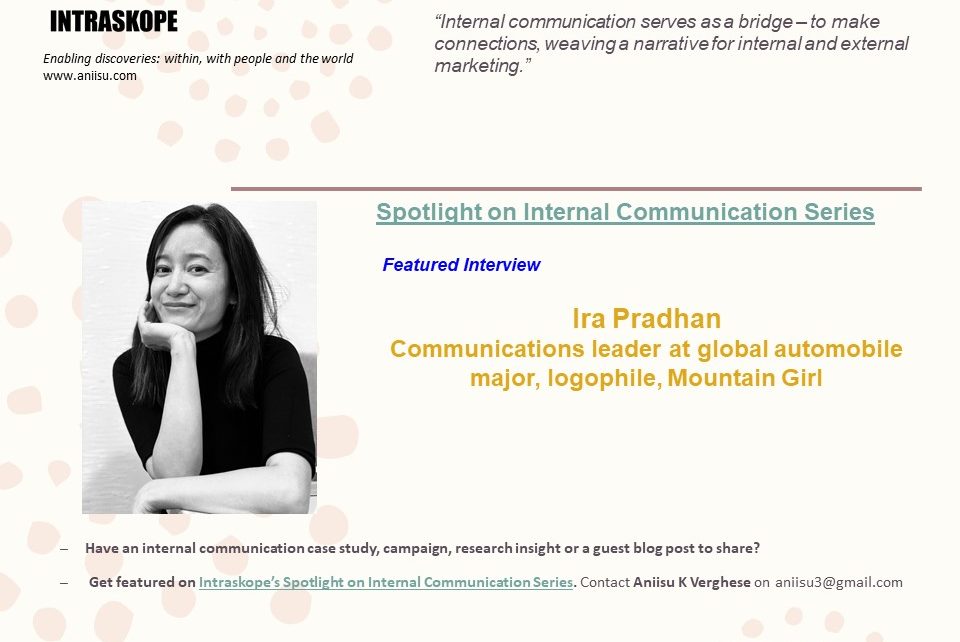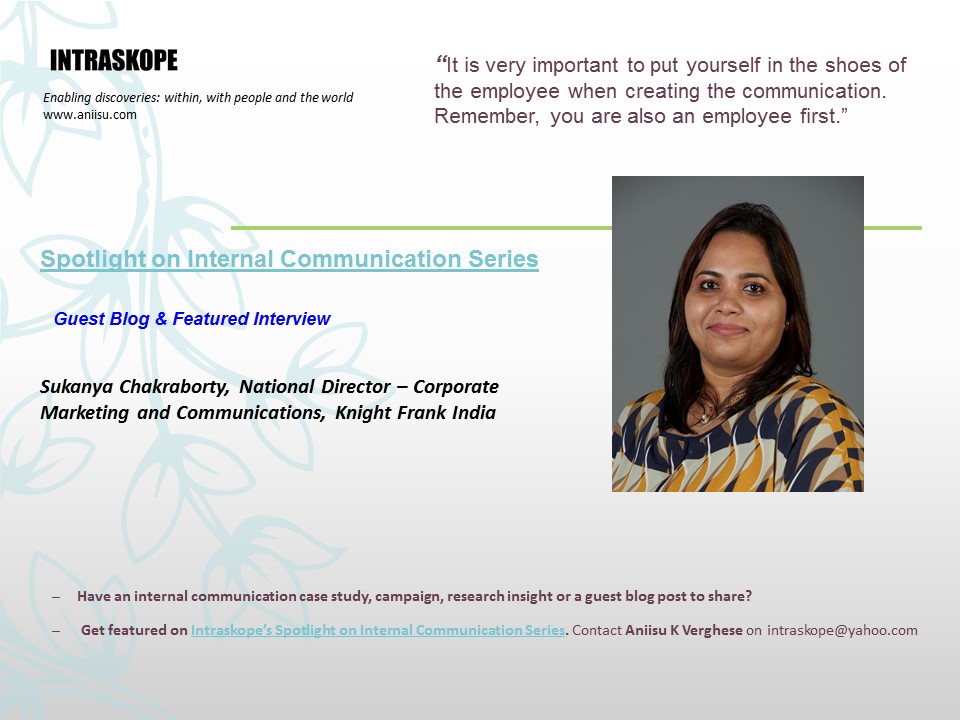Interview with Ira Pradhan – Communications Leader at a Global Automobile Major, India
Pleased to share the 32nd edition of Intraskope’s Spotlight on Internal Communication Series features Ira Pradhan. Watch the complete video interview on You Tube or read the transcript below. Ira is a Corporate Communications Leader with experience in the healthcare, consumer electronics, information technology, retail and the automotive industries. In a career spanning over 15+ years as a communications expert, she has championed and led programs on employee engagement & advocacy, employer branding, diversity & inclusion, corporate social responsibility, public relations, corporate events and social media. In addition, she has partnered with several sustainable business practices, diversity and inclusion programs. I have known Ira for many years, seen her grow in strength and curate a voice of her own among communication peers. Very delighted to feature her on my blog.
Interview
- What does internal communication mean to you?
I want to start by saying internal communications to me is an important function that senses the pulse of the organization and helps connect people, leaders and employees and everyone in general. Today, the line between internal and external communications has become very thin. What goes inside could go outside. While we consider internal audience as captive, with almost everyone on social media, the need for transparency is higher than ever before. As David Ogilvy said, ‘the consumer is not an idiot, she is your wife’. So all employees are your consumers in some way and there lies plenty of insights. I’ve always handled internal communications as part of my portfolio. I love doing employee campaigns, engagements and CSR and events. I can safely say I’ve never got bored in my job, not one day!
2. Please share an example/campaign that you are personally proud of working on and that made a significant impact to your organization. Kindly elaborate with proof points
I am fortunate, I had a chance to work on many such initiatives and campaigns that touches people and connects them. One that I am especially proud of is working on a sustainability campaign at a previous employer. As a huge organization, we were in multiple geographies – 54 countries across the world. At each of these locations we did a lot of initiatives which were not tied together. And there we spotted an opportunity for further building our brand and reputation. Especially in the environment sustainability space. The data was scattered, and the storyline was missing. While I was not the lead for the project, I was passionate about the topic. I had this opportunity to talk to people from all the locations worldwide including many in India to collect data points and great examples of what we had being doing in this topic. We created case-lets (mini case studies) to tell the stories. Finally, when collated, we had so many positive stories to tell, we ended up being recognized for our great sustainability practices. The stories helped in building the brand further and the data points were too hard to miss. Here’s where our job gets brilliant – we can pick up stories that can help your brand. We don’t just wait for the stories to come to you. It was a huge effort, and one of those which I am proud of.
3. What is the biggest challenge you face while going about managing internal communication?
Structured thinking. Internal communication is about brand building, like any other PR domain. Understanding what comprises a brand is very important. Every organization is different because of this composition. Staying agile and having flexible talent are big challenges everywhere. The other is having heterogenous people in your team matters. Being inclusive helps organizations to embrace communications as well as communicators. Once organizations see the value and gains, they are on board.
4. What according to you is the biggest opportunity that internal communicators have?
Lots of opportunities. Employees are the most trusted source of information when it comes to an organization – which is why we have people stories. And with everyone on social media, everyone is a brand ambassador. I handled internal communications for an organization which had over a hundred thousand employees and for an organization with homogenous talent and a lot smaller. There are opportunities galore – un the bigger organization, I saw an opportunity to be able to influence such a huge number of people, positively with every communication I did. In the smaller one, connecting everyone for improved collaboration – for business and innovation was satisfying.
5. How can internal communicators add more value to the business?
Internal communication serves as a bridge. We can help by going from taking information to making a connection. The technical stories can be woven into a narrative that helps in internal and external marketing. When we see everything through a ‘brand’ lens, no matter the variety, a singular message comes through. I work with various business units and all of them are different in terms of scope, scale, value and impact. It’s very important for communications to thoroughly understand each unit to help weave the stories. Only then it is possible to seek opportunities and add value.
6. What is your advice for people who are keen to join internal communication and make a career? What skills must they have or develop?
Being agile, flexible and inclusive helps. Stringing narratives together, simplifying complex topics and story-telling are very important skills. For this of course, one must be like Sherlock Holmes – ask lots of questions, be curious, read a lot (read a variety of subjects) – to infuse life into a brand. You need deep knowledge, creativity and strong language skills.
7. What advice do you have for women in communications and how can they become their best in this domain? What challenges did you face and how did you overcome it?
Professionalism is very important. Being a thorough professional makes you stronger as a go-to person for topics that matter in communications. While this is true for both genders, for women like me, considering we face inclusivity challenges and work-life balance concerns, it’s even more crucial.
Most women are traditionally at the center of the circle of influence, especially in families. This makes most of them natural communicators. However, the barriers we face at work is almost the same as at home. Center of influence and yet, not always the decision-maker. This can be quite a hurdle including behaviors towards women such as unconscious biases. So, unless we become more aware of inclusion it can be tough to overcome these traditional shackles.
Personally, I have faced diversity and inclusivity issues – be it racial, gender, communal and what have you. In my early years, as a North-Easterner (I hail from Sikkim), you are discriminated – people used to see us as less educated. Then later it’s more to do with being or looking too young. And then it’s when you become a mother that you get discriminated against. It’s true when they say you must be twice as good to have half of what they have for all of these cases. Yet, you persevere to make your dreams come true. You do it for you and for your community. Every time I get involved in a topic, I always keep in mind, our community from the North East, the women, the communicators – making a difference to them, through my actions is the most fulfilling thing! Focusing on that helps me overcome challenges.
Last year, in a study among women in PR, it was found that the lack of role models, supportive systems and people, inclusive environment, flexibility in working are among key factors that affect the growth of women. I realized I wasn’t alone. Now the awareness is so much more, and we are slowly but surely moving forward.
Am happy to be founding member of Global Women in PR, India Chapter, GWPR as we call it. We launched it this year to with a goal of producing more leaders in the PR industry through coaching and mentoring, sharing experiences and of course with some of the most well-known, successful PR leaders in the group we are sure there will be no dearth of role models. Exactly what I would have liked to have about 15 years ago, which is why am super proud to be a part of it.
8. What trends do you spot with internal communications?
For internal communications, just like the rest of the industry, digital storytelling will still be relevant and more so. We must understand that people consume information differently which is why we have so many social channels. It should be the same for internal communications – we should have bite-sized, long form, visual, video, digital, static, interactive. Also, the ‘my story’ format over the years have taken precedence. And why not, we learn so much from experiences of others. We travelled the world reading books as children. Fundamentally, we remain the same. To be honest, the more things change, the more it remains the same. I can see more people stories coming up and alive once again using different channels and platforms. Real, authentic stories, from the horse’s mouth.
____________________________________________________________________________
Keen to contribute and participate in the ongoing series on Intraskope where we put the spotlight on thought leadership, great ideas, and practical solutions? Look up the previous stories from organizations featured on the Intraskope’s Spotlight on Internal Communication Series here – Falabella, Brillio, UAE Exchange, Apeland, M.H. Alshaya Co, Proctor & Gamble, Infosys, SOBHA Ltd., ICICI Securities, First Advantage, CK Birla Group, TVS Motors, GE, Suzlon, Tata Sons, Percept, Knight Frank, TCS Europe, Vedanta, Oxfam, Danske Bank, Diageo, Pandora, Symantec, ISS Global Services, Telia, Thomson Reuters, IBM, General Motors, Intelligence India Software Solutions and Philips.
Intraskope (www.aniisu.com) is the first blog on internal communications in India and among the earliest around the globe. Begun in 2006, the blog has over 1000 posts on topics such as employee engagement, leadership communication and employee branding and receives thousands of visits from across the world. The blog, receives over 1,50,000 visits every month from over 50 countries globally, offers learning resources for practitioners, academicians, and students including industry workshops, research reports, and checklists. Intraskope has been featured on leading global internal communication forums like Simply-Communicate, IC Kollectif and International Association of Business Communicators. It is hosted by Aniisu K Verghese, author of Internal Communications – Insights, Practices & Models (Sage, 2012).
Look up resources you can use:
• Internal Communications Series: https://forms.gle/KcqmPzLwq7NQi5Km6
• Chat with Aniisu – Internal Communications: https://www.instamojo.com/intraskope/connect-with-aniisu-60-minute-personalized-d/?ref=store
• Internal Communications workshops: https://bit.ly/2zdBRl1
- YouTube channel: https://www.youtube.com/channel/UCzCaRB-cFYGZTaO5ZfvlxDA/
- Medium: https://medium.com/@aniisu3
If you are an internal communication leader working in a firm or a not-for-profit anywhere in the world and have an internal communication case study, campaign, research insight or a guest blog post to share please contact me on [email protected]
You can also visit my website www.intraskope.com and You Tube channel to know more about my work.

